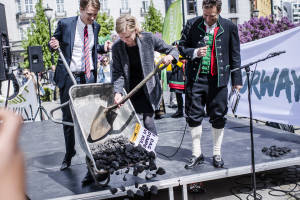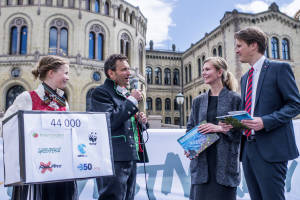 Here in Norway, we recently secured one of our biggest climate wins, if not one of the world’s biggest climate wins. Early June, Parliament decided that the Norwegian Government Pension Fund (often called “the oil fund”) is to divest from coal burning and coal producing companies. The decision means that about £7.7 billion GBP ($8.4 billion USD)will be divested from coal companies. This is an overwhelmingly important decision! I would like to help more campaigners achieve the same – so I have tried to compile how we did it, in just 6 lessons:
Here in Norway, we recently secured one of our biggest climate wins, if not one of the world’s biggest climate wins. Early June, Parliament decided that the Norwegian Government Pension Fund (often called “the oil fund”) is to divest from coal burning and coal producing companies. The decision means that about £7.7 billion GBP ($8.4 billion USD)will be divested from coal companies. This is an overwhelmingly important decision! I would like to help more campaigners achieve the same – so I have tried to compile how we did it, in just 6 lessons:
1. A clear recipe for divestment
Together with urgewald and Greenpeace Norway, my organization Framtiden i våre hender, launched a report , where we showed how the Norwegian oil fund was heavily invested in coal companies. At the time, we found coal investments worth bewildering 9,4 billion GBP (10,3 billion USD). It gained wide media attention when it was launched, and enabled us to provide solid numbers and facts to politicians, the media and public. Thus from an early point, we were able to shape and “own” the debate on coal divestment in Norway.
In the report, we also put together a “recipe for divestment”. I believe this was fundamental for securing the win by making the divestment debate more concrete. The recipe was mainly a way of defining coal companies, and by doing so we could create a list of companies that should be divested from. That way, we were able to break the issue of divestment into tangible figures and companies. No-one had ever done that before.
2. Seize the moment
A win is always achieved with a fair amount of luck. In a way that is unfortunate, because it means that it is hard to replicate the success. On the other hand, it also means that there could be a win for you around the corner even though have not considered it likely; you simply have not included luck in your equation.
However, in order to facilitate for luck, you need to be ready to seize the opportunities that comes your way. In our case, there was a variety of such factors.
For instance, there had been a gradual, strategic shift within the Labour Party, Norway’s biggest political party. They had a new party leader who needed to promote himself and prove that Labour is taking climate issues seriously. Also, local elections are coming up, the Paris summit is drawing closer, coal companies are performing extremely poorly, Norway has very few financial interests vested in coal etc…etc. All of this added up to a momentum, just waiting to be seized!
My organization has been, and still is working for the oil fund to do a full divestment from all fossil fuel companies. However, after some time we realized that we needed to adhere to the current political context. Thus, we decided to focus strictly on coal divestment. In a way, this meant we reduced our moral high ground by emphasizing less on “100% fossil free”. But we saw the prospect of succeeding as bigger, and it gave us an opportunity to spend more time on securing a strong resolution to be passed in Parliament. This was our way of seizing the moment. The strategic pick made it easier for us to be more focused, and put more emphasis on stigmatizing coal as an investment (which, according to this oxford report, is a smart thing to do).
3. Build alliances
In my organization, we were four people working on divestment related issues, and we thought to ourselves – what can the four of us really achieve? It was not until international organizations such as 350.org and various international media started emailing us and asking what was going on in Norway, that we realized just how big this issue was. Then we moved quickly!
We joined the Norwegian environmental organizations who had been most active on issues regarding divestment and renewable investments in the oil fund, and we reached out to potential partners and donors in other countries. Seen as we expect the Norwegian decision to be followed by a rush of coal divestments globally (as does international financial experts), our work should be of international interest. And it was! We were able to secure additional funding which allowed us to focus more time and people power to coordinate and be fully dedicated to the divestment campaign. Without this, I do not think we would have achieved the same results.
4. Understand the political processes
In Norway there is a high degree of transparency in Parliamentary processes. Early on, we got to know the dates of when the Finance Committee would discuss and vote on the subject.
As a campaigner, it is important to know what is formality, and when and where the real decision is made. Right from the start, we put up a clear timeline with key decision dates and other political events that could help us amplify the message– such as the various Political Parties’ General Assemblies.
As a starting point for any campaign, you need to map the political scenery, and understand who is the key decision makers and influencers. In Norway, the Labour party was key, but also the Liberals. By cooperating with the Liberals who were putting forward their own more radical proposition for divestment, the Labour party was pressured to move further, otherwise their own suggestion would have seemed weak.
5. Coordinate
After agreeing on cooperation sometime in March, we made sure to have a shared campaign strategy. “We” were Framtiden i våre hender (my organization), Greenpeace Norway, urgewald, WWF Norway and 350.org. But we shared a petition, key events and messaging with Avaaz as well, and spread much of our strategy with certain labour unions, religious faith groups, political parties and development aid organizations.
This meant that anyone from the outside who were interested in the Norwegian divestment decision would be directed to us, and we avoided conflicting messages. Coordination might mean you spend more time developing joint messaging and trying to keep everyone up to date, and each organization might have had to compromise a little on visibility. But the net effect for us was a much more coherent and unified campaign.
6. Flexible communication strategy
When we were planning the last phase of the campaign, it became clear that our communications strategy had been dominated by environmental and financial arguments. Both are key, especially toward politicians. But we were lacking the humanitarian arguments to inform a broader public on the effects coal. Because of this, we decided to show more people and less nature and numbers in the final and escalated stage of our campaigning efforts.
We organized an “Affected People’s Week”, bringing campaigners and people affected by the coal industry from Colombia, China, the United States, the Philippines and South Africa. During their stay, we organized media interviews, meetings with parliamentarians, the council of ethics and the councillor of Oslo, along with public meetings including one within the Parliament building itself. We also ran ads in major newspapers, and on billboards in the main metro station used by parliamentarians.
By joining forces, we secured more than 44000 signatures on a joint petition. We handed them over to key Labour party politicians on May 27th, in a public event in front of Parliament. This was the day before the decision was due. Simultaneously, we carried out a twitterstorm where we targeted selected politicians. That week there were 11.36 million #DivestNorway -Twitter impressions (total number of times users have seen the content).
That same evening, the news broke from within the Finance Committee; the committee was unanimous in their recommendation – the oil fund would divest from coal companies, using a similar definition as the one we had put forward. Words simply do not cover the joy I felt!
I believe that the big push in campaigning efforts, with the twitterstorm as a climax, was instrumental in creating a sufficient sense of urgency to force the governing parties to join the consensus.
It has been an incredible journey. I have to say a massive thanks to all the organizations and amazing people who have been involved – you all know who you are. Together we really can do great things. Moreover, I hope many more will gain some valuable lessons from this little blog entry.
A luta continua!
